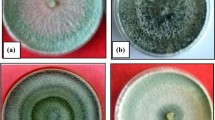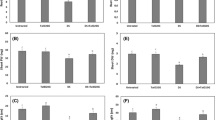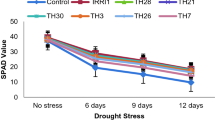Abstract
Certain number of commercial products has been developed to grow stress resistant plants for the sustainability of agriculture in current era with full of energy dependency and hunger besides global warming. Given the risk of these products on the microbial environment in the rhizosphere and food security of mankind due to the accumulated chemical pollution through the food web, organic fungal plant growth promoting agents might be used. Hence, effects of Trichoderma lixii ID11D (TXD), our local fungal isolate on Zea mays L. cv. Samada 07 as a seed biopriming agent was investigated under dose dependent NaCl stress in this study. Fungus was characterized based on ITS (internal transcribed spacer) regions via clustering approach after isolated from tea plantation area. The higher the NaCl concentration, the more effective the TXD was observed. Improved electron transport rate (ETR), maximum quantum efficiency of PS II (Fv/Fm), the effective quantum yield of PS2 (ΦPS2), photochemical quenching (qP) and decreased non-photochemical quenching (NPQ) was detected in TXD primed plants after NaCl expose. TXD seed biopriming increased the lengths, fresh and dry weights of root/shoots and decreased the lipid peroxidation (MDA) remarkably. Non-enzymatic pathway was found to be more effective than enzymatic one for seed bioprimed plants proven by higher RWC, soluble protein, proline, chlorophyll, carotenoid, and less H2O2 and MDA levels under each dose of NaCl. Detected phenotypic and biochemical improvements pave the way of the potential usage of the formulated fungus biopreperations as a pre-harvest agent in agriculturally important cereals in the future and going beyond lab-based level.




Similar content being viewed by others
References
Aebi H (1983) Catalase. In: Bergmeyer H (ed) Methods of enzymatic analysis, 3rd edn. Weinheim, Germany, pp 273–286
Ahmad P, Hashem A, Abd-Allah EF, Alqarawi AA, John R, Egamberdieva D, Gucel S (2015) Role of Trichoderma harzianum in mitigating NaCl stress in Indian mustard (Brassica juncea L) through antioxidative defense system. Front Plant Sci 6:868–883
Arnon DI (1949) Copper enzymes in isolated chloroplasts. Polyphenoloxidase in Beta vulgaris. Plant Physiol 24:1–15
Bates LS, Waldren RP, Teare LD (1973) Rapid determination of free proline for water-stress studies. Plant Soil 39:205–207
Behera RK, Mishra PC, Choudhary NK (2002) High irradiance and water stress induced alterations in pigment composition and chloroplast activities of primary wheat leaves. J Plant Physiol 159:967–973
Bradford MM (1976) A rapid and sensitive method for the quantitation of microgram quantities protein utilizing the principle of protein-dye binding. Anal Biochem 72:248–254
Cabot C, Sibole JV, Barceló J, Poschenreider C (2014) Lessons from crop plants struggling with salinity. Plant Sci 226:2–13
Castillo FJ (1996) Antioxidative protection in the inducible CAM plant Sedum album L. following the imposition of severe water stress and recovery. Oecologia 107:469–477
Chen C, Tao C, Peng H, Ding Y (2007) Genetic analysis of salt stress responses in asparagus bean (Vigna unguiculata L. ssp. Sesquipedalis verdc.). J Hered 98(7):655–665
Chepsergon J, Mwanburi L, Kassim MK (2014) Mechanism of drought tolerance in plants using Trichoderma spp. Int J Sci Res 3:1592–1595
Colla G, Rouphael Y, DiMattia E, El-Nakhel C, Cardarelli M (2015) Co-inoculation of Glomus intraradices and Trichoderma atroviride acts as a biostimulant to promote growth, yield and nutrient uptake of vegetable crops. J Sci Food Agric 95:1706–1715
Contreras-Cornejo HA, Macías-Rodríguez L, Alfaro-Cuevas R, López-Bucio J (2014) Trichoderma spp. improve growth of Arabidopsis seedlings under salt stress through enhanced root development, osmolite production, and Na+ elimination through root exudates. Mol Plant Microbe Interact 27:503–514
Crutzen PJ, Mosier AR, Smith KA, Winiwarter W (2008) N2O release from agro-biofuel production negates global warming reduction by replacing fossil fuels. Atmos Chem Phys 8:389–395
Cuartero J, Maria C, Bolarin VM, Benito P (2009) Molecular tools for enhancing salinity tolerance in plants. In: Jain SM, Brar DS (eds) Molecular techniques in crop improvement. Springer, Netherlands, pp 373–405
Dhindsa RS, Matowe W (1981) Drought tolerance in two mosses: correlated with enzymatic defence against lipid peroxidation. J Exp Bot 32:79–91
Elias RJ, Kellerby SS, Decker EA (2008) Antioxidant activity of proteins and peptides. Crit Rev Food Sci Nutr 48(5):430–441
Flexas J, Diaz-Espejo A, Galmés J, Kaldenhoff R, Medrano H, Ribas-Carbo M (2007) Rapid variations of mesophyll conductance in response to changes in CO2 concentration around leaves. Plant Cell Environ 30:1284–1298
Flowers TJ, Flowers SA (2005) Why does salinity pose such a difficult problem for plant breeders? Agric Water Manag 78:15–24
Food and Agriculture Organization of the United Nations (2016) Save and grow in practice maize rice wheat. A guide to sustainable cereal production. Rome
Foyer CH, Halliwell B (1976) Presence of glutathione and glutathione reductase in chloroplast: a proposed role in ascorbic acid metabolism. Planta 133:21–25
Fu X, Xing F, Wang N, Peng L, Chun C, Cao L, Ling L, Jiang C (2014) Exogenous spermine pretreatment confers tolerance to combined high-temperature and drought stress in vitro in trifoliate orange seedlings via modulation of antioxidative capacity and expression of stress-related genes. Biotechnol Biotechnol Equip 28(2):192–198
Garbeva P, Van Veen JA, Van Elsas JD (2004) Microbial diversity in soil: selection of microbial populations by plant and soil type and implications for disease suppressiveness. Annu Rev Phytopathol 42:243–270
Gielen B, Markus L, Gaby D, Ursula M, Fabrice F, Christian H, Rainer M, Roland V, Reinhart C (2007) Chronic ozone exposure affects leaf senescence of adult beech trees: a chlorophyll fluorescence approach. J Exp Bot 58(4):785–795
Goettel MS, Inglis DG (1997) Fungi: Hyphomycetes. In: Lacey LA (ed) Manual of techniques in insectpathology. Academic Press, London, pp 213–249
Guler NS, Pehlivan N, Karaoglu SA, Guzel S, Bozdeveci A (2016) Trichoderma atroviride ID20G inoculation ameliorates drought stress-induced damages by improving antioxidant defence in maize seedlings. Acta Physiol Plant 38(6):1–9
Gurr SJ, Rushton PJ (2005) Engineering plants with increased disease resistance: what are we going to express? Trends Biotechnol 23(6):275–282
Harman GE, Kubicek P (1998) Trichoderma and Gliocladium. Enzymes, biological control and commercial applications. Taylor and Francis, London
Hasegawa PM, Bressan RA, Zhu JK, Bohnert HJ (2000) Plant cellular and molecular responses to high salinity. Annu Rev Plant Physiol Plant Mol Biol 51:463–499
Hashem A, Abd Allah EF, Alqarawi AA et al (2014) Alleviation of abiotic stress in Ochradenus baccatus (Del.) by Trichoderma hamatum (Bonord.) Bainier. J Plant Interact 9:857–868
Heath RL, Packer L (1968) Photoperoxidation in isolated chloroplast. I. Kinetics and stochiometry of fatty acid peroxidation. Arch Biochem Biophys 125:189–198
Hoyos-Carvajal L, Orduz S, Bissett J (2009) Growth stimulation in bean (Phaseolus vulgaris L.) by Trichoderma. Biol Control 51:409–416
Jaspars EMJ (1965) Pigmentation of tobacco crown-gall tissues cultured in vitro in dependence of the composition of the medium. Physiol Plant 18:933–940
Karaoglu SA, Ulker S (2006) Isolation, identification and seasonal distribution of soilborne fungi in tea growing areas of Iyidere-Ikizdere vicinity (Rize-Turkey). J Basic Microbiol 46:208–218
Khodary SEA (2004) Effect of salicylic acid on the growth, photosynthesis and carbohydrate metabolism in salt stressed maize plants. Int J Agric Biol 6:5–8
Kottb M, Gigolashvili T, Großkinsky DK, Piechulla B (2015) Trichoderma volatiles effecting Arabidopsis: from inhibition to protection against phytopathogenic fungi. Front Microbiol 6:995
Mastouri F, Björkman T, Harman GE (2012) Trichoderma harzianum enhances antioxidant defens of tomato seedling and resistance to water deficit. Mol Plant Microbe Interact 25(9):1264–1271
Mattioli R, Costantino P, Trovato M (2009) Proline accumulation in plants: not only stress. Plant Signal Behav 4(11):1016–1018
Maxwell K, Johnson GN (2000) Chlorophyll fluorescence—a practical guide. J Exp Bot 51:659–668
McKeon TA (2003) Genetically modified crops for industrial products and processes and their effects on human health. Trends Food Sci Technol 14:229–241
Meloni DA, Marco AO, Carlos A, Martinez JC (2003) Photosynthesis and activity of superoxide dismutase, peroxidase and glutathione reductase in cotton under salt stress. Environ Exp Bot 49(1):69–76
Munns R, Gilliham M (2015) Salinity tolerance of crops—what is the cost? New Phytol 208:668–673
Munns R, Schachtman DP, Condon AG (1995) The significance of a two-phase growth response to salinity in wheat and barley. Funct Plant Biol 22:561–569
Navazio L, Barbara B, Roberto M, Anna Z, Sheridan W, Paola M, Matteo L (2007) Calcium-mediated perception and defense responses activated in plant cells by metabolite mixtures secreted by the biocontrol fungus Trichoderma atroviride. BMC Plant Biol 7:41
Parvaiz A, Satyawati S (2008) Salt stress and phyto-biochemical responses of plants-a review. Plant Soil Environ 54:89–99
Pehlivan N, Li S, Jarrett P, Yang X, Mishra N, Chen L, Kadioglu A, Shen G, Zhang H (2016) Co-overexpressing a plasma membrane sodium/proton antiporter and a vacuolar membrane sodium/proton antiporter significantly improves salt tolerance in transgenic Arabidopsis plants. Plant Cell Physiol 57(5):1069–1084
Potrykus I (2001) Golden rice and beyond. Plant Physiol 125(3):1157–1161
Rodriguez RJ, Henson J, Van Volkenburgh E, Hoy M, Wright L, Beckwith F, Kim Y, Redman RS (2008) Stress tolerance in plants via habitat-adapted symbiosis. Int Soc Microb Ecol 2:404–416
Savvides A, Ali S, Tester M, Fotopoulos V (2015) Chemical priming of plants against multiple abiotic stresses: mission possible? Trends Plant Sci. doi:10.1016/j.tplants.2015.11.003
Sheng M, Tang M, Chen H, Yang B, Zhang F, Huang Y (2008) Influence of arbuscular mycorrhizae on photosynthesis and water status of maize plants under salt stress. Mycorrhiza 18:287–296
Shoresh M, Harman GE (2008) The relationship between increased growth and resistance induced in plants by root colonizing microbes. Plant Signal Behav 3:737–739
Shoresh M, Harman GE, Mastouri F (2010) Induced systemic resistance and plant responses to fungal biocontrol agents. Annu Rev Phytopathol 48:21–43
Shukla N, Awasthi RP, Rawat L, Kumar J (2012) Biochemical and physiological responses of rice (Oryza sativa L.) as influenced by Trichoderma harzianum under drought stress. Plant Physiol Biochem 54:78–88
Stavridou E, Hastings A, Webster RJR, Paul RH (2016) The impact of soil salinity on the yield, composition and physiology of the bioenergy grass Miscanthus x giganteus. GCB Bioenergy. doi:10.1111/gcbb.12351
Urbanek H, Kuzniak-Gebarowska E, Herka K (1991) Elicitation of defense responses in bean leaves by Botrytis cinerea polygalacturanase. Acta Physiol Plant 13:43–50
Velikova V, Yordanov I, Edreva A (2000) Oxidative stress and some antioxidant systems in acid rain-treated bean plants, protective role of exogenous polyamines. Plant Sci 15:59–66
Verma M, Satinder K, Brara RD, Tyagia RY, Surampallib JRV (2007) Antagonistic fungi, Trichoderma spp.: panoply of biological control. Biochem Eng J 37:1–20
Verslues PE, Agarwal M, Katiyar-Agarwal S, Zhu J, Zhu JK (2006) Methods and concepts in quantifying resistance to drought, salt and freezing, abiotic stresses that affect plant water status. Plant J 45:523–539
Vos CM, De Cremer K, Cammue BP, De Coninck B (2015) The toolbox of Trichoderma spp. in biocontrol of Botrytis cinerea disease. Mol Plant Pathol 16:400–412
Zhao Z, Zhang W, Stanley BA, Assmann SM (2008) Functional proteomics of Arabidopsis thaliana guard cells uncovers new stomatal signaling pathways. Plant Cell 20(12):3210–3226
Acknowledgements
This work was financed by the Recep Tayyip Erdogan University Research Fund (Project Numbers: 2012.102.03.3 and 2015.53001.102.03.07). We thank PhD candidate Sule Guzel for her valuable help.
Author information
Authors and Affiliations
Corresponding authors
Additional information
Communicated by S. Weidner.
Co-first authors: Necla Pehlivan and Abdullah Muhammed Yesilyurt.
Rights and permissions
About this article
Cite this article
Pehlivan, N., Yesilyurt, A.M., Durmus, N. et al. Trichoderma lixii ID11D seed biopriming mitigates dose dependent salt toxicity in maize. Acta Physiol Plant 39, 79 (2017). https://doi.org/10.1007/s11738-017-2375-z
Received:
Revised:
Accepted:
Published:
DOI: https://doi.org/10.1007/s11738-017-2375-z




